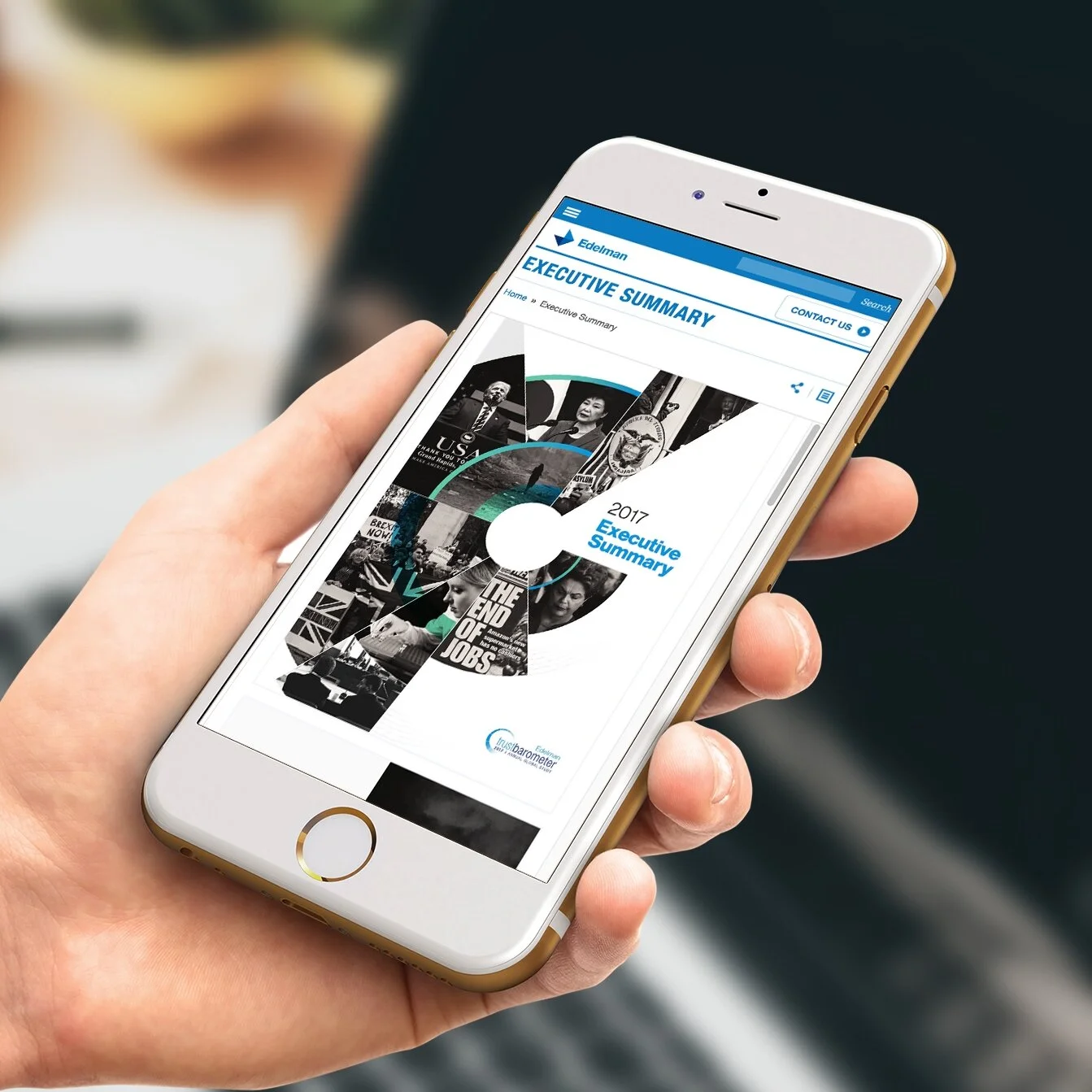It’s easy to celebrate the completion of your new video and think that it will now magically get seen by the right people. But this is generally not the case. Knowing how to distribute your video is essential to making it work hard for you.
How Communication Can Build a Values-Driven Culture
There’s no better way to bring your mission and values off your walls and into your halls than by showing your leaders and employees walking the talk.
And there’s no better communication tool than video to build a values-driven culture. Video can capture symbolic moments in which people bring values to life in authentic ways—and spread the role-modeling throughout the organization.
Neutral Color Guide (When to Use Neutrals)
While colors are trending towards bright, vivid hues, the hard-working neutrals—white, gray, black, and brown—have a staying power because of their flexibility. They might not be your favorite color, they don't tend to steal the show, they aren't usually even noticeable, but they are the bedrock of strong design.
8 Ways to Create Authentic Patient Video Stories
In today’s market, video marketing is an essential—and nothing works like a riveting patient story.
But not all patient video stories are created equally. Some feel flat, boring, too promotional or too predictable, while others depict a relatable experience and compel the viewer to feel connected to the organization.
Trust of CEOs Has Never Been Lower: Here Are 9 Tips on Communicating to Build Trust
Trust is the currency of leadership. It’s what inspires others to follow, support, and engage in a leader’s vision.
But there is troubling news on this front: this precious asset is in steady decline, with only 37% of the general population saying that CEOs are credible, according to the Edelman Trust Barometer, a global study with 33,000 respondents
This general mindset of distrust filters into the workforce of every organization—even into those with high trust factors. That’s why understanding how to use communication to build trust is such a timely skill to cultivate—and one that almost every leader can improve upon.
17 Top Internal Communication Channels [Infographic]
The days of a one-size-fits-all channel are gone. As many as five generations with diverse communication appetites make up today’s workforce—making the job of the communicator increasingly complex. Some workers are at desks and access email, while others rarely do. Reaching them all requires using a wide range of channels and multiple deliveries of the same message. Here are the most popular channels being used for internal communication.
CMBell Company and Clients Win Five National Awards
Creative work by CMBell and our clients has garnered five awards from the 34th Annual Healthcare Advertising Awards competition.
In this year’s competition, nearly 4,000 entries were judged by a national panel who reviewed creativity, quality, message effectiveness, consumer appeal, graphic design, and overall impact.
Hats off to our creative team and to our clients for earning this recognition!
Setting Up Video Interviews—A Project Manager’s List
The interview is the foundation for many kinds of videos—from executive updates to a good story. Setting up a good video interview starts with you, the project manager, before the video crew ever arrives. Here are some tips we share with our clients that can help you get a better video.
How Video Can Help You Become a Better Fundraiser
A local shelter came to us looking for ways to support their largest fundraising campaign in history—a new facility for women and children looking to transition from homelessness to lives of self-sufficiency. Their story is powerful, but they needed a way to tell it more broadly, and that’s how this video was born.
What Kind of Communication Do Millennials Want at Work?
When it comes to millennials, one of the most important actions employers can take to improve their engagement is to offer routine feedback. According to a recent Gallup report, only 19% of young workers state that they regularly receive feedback, and just 17% acknowledge that the feedback they get is meaningful.
This type of internal communication could involve technologies like Slack or others that connect managers and their teams with real-time feedback.
You can read more about the Gallup survey and how to engage your workforce here. The bottom line: millennials have grown up in a world of continuous feedback, which has deeply shaped their employment expectations. Employers who understand and respond to this will see higher employee engagement among this demographic.
5 Reasons Your Company Stories Aren’t Growing Your Business
You already believe in the power of story. You’ve seen how it can sell, persuade, compel, inspire—even better than a well-crafted argument. But are your stories helping you build your business?
If not, here are some possible reasons—and tips on what you can do about it:
A Behind-the-Scenes Look at Creating CMBell’s New Visual Brand
Communications has never been more important to businesses and organizations, and as we look at trends and needs among our clients, we’re convinced that our new mission statement precisely describes the space we’ll occupy: Creating signature communications that drive purpose and grow business.
As an outgrowth of that, we’ve updated our visual brand, and in this entry, we’ll take you behind the scenes on some of the work that led up to this.
How the “Customer Is Always Right” Mindset Can Destroy Employee Engagement
When Vineet Nayar joined HCL Technologies as the CEO, he vowed to transform it into a company where employees were first—and customers were second.
Nayar believed that if he could inspire his people to pursue a vision which they owned and which still aligned with the company’s, magic would happen. And his experiment proved him right.
On this premise, he set to work to make it one of the fastest-growing and most profitable global IT services as well as one of the 20 most influential companies in the world.
But it required challenging the conventional wisdom that the customer is always right.
While at some level, this commonly heard business maxim speaks truth, in application it can lead to deadly results for employee engagement if we don't talk about where the line drawn on customer behavior.
As Alexander Kjerulf, author of Happy Hour is 9 to 5, tells it, Southwest drew a line with a frequent flyer who consistently complained about things that were simply part of their business model—like no assigned seats, no first class, no in-flight meals, and the casual atmosphere.
Wearied by her repeated tirades, Southwest's customer relations people eventually sent her comments on to then-CEO Herb Kelleher, who replied: "Dear Mrs. X, We will miss you. Love, Herb."
“Believing the customer is always right is a subconscious way of favoring the customer over the employee which can lead to resentment among employees. … Put employees first and they will be happy at work," says Kjerulf.
It is not too low of a bar to expect civility of both employees and customers, and yet most of us have witnessed the lack of it too many times in the workplace. As is often the case, the challenge is in the execution. It can feel a lot like refereeing siblings in a "he started it, she started it" squabble. But, as leaders, we're called to adjudicate these situations to determine whether an employee's behavior wrongly incited a frustrated customer, or whether a customer is being unreasonable, rude, or insulting.
To preserve a workplace with high engagement, a business must live its values—not just talk about them. This could mean walking away from some clients if their behavior does not allow the company to live up to its values of treating its own people with respect. Tolerating rude, insulting, or abusive behavior by customers drains the energy of employees and lowers morale. It effectively tells the employee that they do not deserve better treatment from others.
It's important to think about where popular ideas like "the customer is always right" reach their limits. Intuitively, we know that treating people well and providing a work environment that isn't hostile can help them flourish. This kind of environment unleashes loyalty, creativity, and the desire to take better care of the customers. In the end, respecting and retaining top employees not only impacts engagement, but ensures that your customers have the very best people attending to them.
How You Can Use Internal Communication to Build Employee Engagement
It’s no secret that employees who buy into your company’s mission and vision will make you more successful.
In fact, Gallup says that the most engaged teams will have four times the odds of success compared with teams with low engagement.
So it’s surprising to learn that seven out of 10 employees are not engaged at work. And the cost is real:
Lower productivity
Poorer quality
More safety incidents
Higher absenteeism and turnover
Poorer customer satisfaction
Higher employee health care costs
Today’s Employees Are Overfed—Yet Starved
While several factors impact engagement, communication’s central role can’t be overlooked.
It’s not that employees lack communication—more information than ever is clamoring for their attention. It’s that they are often starved for the right kind of communication at work.
They hear a lot about problems to solve, regulations to meet, targets to reach, and customer concerns. But they hear too little about things that ignite their passion and help them connect their work to their purpose.
Think of communication as nourishment for the soul. Employees need a balanced diet that includes messages that inspire. They need to understand the “Why?” behind what they are asked to do. This includes:
Vision: What the destination is, and how you’ll get there
Mission: Why their work matters
Values: The principles that drive behavior
Strategy: How their work connects to a broader vision
Stories: How their work impacts customers and co-workers
Their role: What’s expected of them
Strategic, intentional communication with your inner circle can change the future of your company. It can help build employee support for your most pressing business goals, revitalize your culture, and spread to your customers in the form of better service and products.
Winning at Business Starts With Your Employees
It’s nearly impossible to win customers if you have not first won the hearts and minds of your own employees.
This is why internal communication is gaining more and more attention and resources. It can:
Connect employees to their purpose
Inspire them with a mission that brings meaning to their work
Give them a better understanding of how their work fits into the company’s strategy
Help them understand and support decisions that are made
Help them deal with change
Build a robust and healthy culture
10 Ways to Up Your Internal Communication Game
So how do leaders get their teams to embrace their vision? To share the same dreams? To move in sync with each other toward a common goal?
Make a strategic communication plan that identifies your key messages, how often and when they’ll be delivered, and the target audience for each. It doesn’t have to be complicated—just clear and executable.
Create a compelling picture of the destination before outlining how you’ll get there. Weave a story around the vision that invites others to step into it, inspires the mind, and ignites curiosity. Once employees know the destination, you can show them the plan to get there.
Make it personal. How will the vision impact employees? What exactly should they do differently? What is their role in success? Why is it important? Use specific examples and stories that draw them in.
Use language employees understand. Corporate-speak weighs down a message, so if you struggle with this, have an outsider review what you plan to say before you deliver it.
Use the media they’re using. While email is still the most used channel for internal communication, video is gaining ground as appetites for this medium soar. A mix of media is best, so don’t rule out in-person forums, print pieces, apps, and intranets. And, of course, all of your digital communication needs to be mobile-friendly.
Engage the senses. Visually rich messages inundate today’s employee—so a slow-moving, text-heavy presentation won’t be the most compelling way to deliver your important messages. Great visuals are now essential to get and keep your listeners’ attention. And, of course, the motion, music, and sound that video offers makes your message even more engaging.
Understand their world. Cognitive overload is real. Employees get too much information—but not enough inspiration. Connecting your ideas to their sense of purpose is the best way to inspire them.
Keep it short. Employees like their information in short, snackable, yet content-rich formats that they can ingest quickly.
Repeat your essential messages. Yes, over and over and over. By the time you’re weary of saying it, it will just be gaining traction.
Listen. Communication is a two-way street. Give employees more than one way to submit questions and ideas, then use that to drive content.
It’s Time to Resource Internal Communication
While 70% of senior leaders value internal communication, only 49% of companies have a written internal communication plan, according to Gatehouse’s State of the Sector 2016 survey on internal communication and employee engagement, which surveyed more than 300 organizations in 70 countries.
Even fewer—27% of those surveyed—have a dedicated budget. This will likely change with the growing concern leaders have about low employee engagement.
If You’re in Health Care, Know This
The unprecedented rate of change and uncertainty in health care leaves employees looking for clarity about what’s most important. Yet even in times of change, engagement is possible.
“Nearly eight in 10 employees are engaged when workers strongly agree there is open communication, opportunities to provide input, a clear connection between current changes and the company’s future, and management support for changes that affect their work group. When employees disagree, a mere 1% are engaged,” according to Gallup.
Gallup says that clear communication and a well-articulated mission and purpose that’s consistent with the culture are two of the strategies top-performing health care organizations handle better than their peers.
Need Help?
Wondering how to put together an internal communication plan, develop your essential message points, or craft a creative narrative that speaks to employees?
20 Memorable Moments from 20 Years of Business
As we celebrate our 20th year in business, we've had a chance to reflect on some of our memorable moments along the way. We share our story for this reason: We hope it will inspire you on your own journey.
1. Ready, Set, Go
I guess you could say that Michael and I opted to live life backwards. Family, friends, and community have always been more important to us than following a prescribed career path. It seemed to make more sense to first decide what kind of life we wanted, and then look for ways to make a living—rather than the other way around. And so we began this journey early on, with a move back to our beloved home town in eastern Washington. With limited options for work in my field here and a growing desire to do work that allowed me more flexibility and time with our then-young sons, I decided to give freelancing a try. When former colleagues started calling me, I began to see a future for this—even though it was still in its infant stages.
2. Let's Call Our Company CMBell
I'd like to say that when we began we had clearly defined business goals. But really, I was entirely pragmatic in those early days. I needed to take whatever work came my way. My North Star was my belief that communication tools and strategies could be used more powerfully to change the course of businesses. But exactly what that would look like, I didn't know.
And that's how CMBell came about. Michael had done consulting and the business name was registered with the state, so that's where our name came from. It left the door open for us to take the business where it needed to go without committing to any one kind of service.
Over the years we've spun a narrative about what it means. CMB can stand for Communications, Marketing, and Branding. It's also the initials of my husband and sons—the people who mean the very most to me in life. But the truth is, it's my husband's moniker—because it started with him.
3. The Power of Believing and a Word of Encouragement
On more than one occasion, good friends and family shored me up with courage, believing in me on those days I wasn't at all sure this idea would work. I specifically remember one day getting a call from my good friend, Beth, now a health care CEO, at a time when I was dispirited. She said to me then: "This could be the best thing that ever happened to you in your career." And she was right. She was one of several who taught me the power of believing in another person and the value of an encouraging word—two ideas that fuel my life today.
4. Take the Step
My husband ponied up the cash to do some promotion in those early days. It seemed so extravagant, but he’s always understood the value of investing in the business. His steady calm through all the ups and downs of business, as well as his I’m-an-engineer-and-I-can-do-anything attitude, has been the bedrock for our business.
5. First Logo
We hired a freelancer to bring to life our idea for a logo. It was a simple black-and-white treatment, but it began our official visual brand journey. Although we weren't even sure what kinds of services would become our primary offerings, we were ready to hit the road and find out.
6. First Hire
Darla took a chance on our little company when it was barely more than an idea. In those days, she toted her work in a portable bin, which she hauled between our home and hers. Her organization, attention to detail, initiative, and commitment to service have been a central force in our growth and success.
7. We Launch a Design Department
We have always believed that good design is essential to communication. Initially this meant hiring freelance talent, but soon our design services had outgrown that model and we hired our first in-house designer. Today, our belief that superior design is essential to any kind of communications is stronger than ever, and our top-drawer design team reflects that commitment.
8. Our First Building
We soon outgrew our home office and embarked on the hunt to find a new location. After purchasing an old building on the main street of our little college town, we went to work remodeling it. It was exciting to have a real office where we could now work together—and have space to grow.
9. The Beginning of Long-Standing Client Relationships
In 1999, we got the contract to help Key Technology, a local manufacturing firm with an international presence, with their annual report. We have just finished designing the 18th annual report for them. What a privilege to work with such a group of hardworking innovators and to see their story unfold over time.
One of the things we most prize today is the long-term relationships we have with so many of our clients like Key Technology. We never take their loyalty for granted.
10. We Move into the Colorado Market
Another important partner to us in those founding years was our good friend John, then-president of a hospital near Boulder. He called on us to help support his marketing and communication work and eventually that led to working with many other clients in Colorado, where we're still helping businesses grow today.
11. Campaign Wins
Our first major campaign was for a hospital's orthopedic program—which had an immediate impact on their bottom line and their physician loyalty. Our most recent successful campaign is an OB campaign that reversed declining market share and contributed more than $600,000 to the bottom line. We now have a highly refined proprietary campaign package of digital and traditional marketing that consistently brings impressive results for clients. There is nothing more exciting than seeing a worthy company grow and knowing that effective communications played a role in it.
12. Second Visual Brand
We were growing into more than a consultancy, and ready to update our visual brand. Our art director paired a classic symbol with our company name to give us a fresh, new look—and launched our blog at the same time.
13. Struggle
Business was going strong and then one of our biggest clients hired new leadership, who brought their own agency relationships to the account. We were heavily dependent on a few clients, and had not spent sufficient time cultivating other clients because we were so busy. We tightened our belts and recruited new clients, grateful for our no-debt operational policy, which allowed us to preserve our talent without layoffs during slow times.
14. Video Expansion
Several years ago it became clear that video and mobile would play an essential role in communications in the future. We made the strategic decision to expand our capabilities in this area and within a short time our schedules were full and we were shooting videos throughout the West Coast.
15. CMBell 2.0
One of the things we love about running a small business is the speed of decision-making. We are always reading the landscape and adapting our business to where the clients' needs are. In 2016, we went through a rebranding process where we refined our mission, vision, and values and charted a course for the years ahead. Our focus today is on helping companies that promote human flourishing. This is expressed more specifically in our new mission statement: Creating signature communications that drive purpose and grow business.
16. 2016 Visual Brand
With greater clarity about our future, we rolled out our new visual brand as its expression. Once again, our art director studied our core ideas and developed a logo that fit our new direction—one that would focus on top-tier business communications and internal communications, with video as a strong core competency. The classic, timeless look fits our love of building things that last.
17. Stepping Up Our Internal Communication Services
While we've worked in internal communication throughout our history, we've increased our capabilities in this area as we see more demand for communication that wins the hearts and minds of employees. Leaders are looking for ways to build culture, to inspire their people, and to help them work together towards common goals.
This is an area in which many companies are just starting to invest, and with real success. We're just completing one of our largest internal communication projects with a health system in which the internal e-letters outperformed the industry average by four times (up to 10x in one case), and 9 out of 10 leaders say that as a result of the communication project, they better understand the why behind their work, the key strategies, and the value of working together.
18. Technology
Someone once asked me what my best business decision was. I answered "marry an engineer." Engineers are wildly versatile, and in my case, my husband has turned out to play an essential role in many things, including the building out of a technology backbone for our firm. In our early days, we could not have afforded someone with his pedigree and expertise, so his contribution was an unexpected bonus.
19. Hire the Best
One of the best things about running your own business is that you get to hand-pick the people you work with every day. We cannot overstate the value we place on this. The people we have chosen to work with us are not only accomplished professionals, but they are like family to us. We couldn't be more excited about building a future with this remarkable team.
20. Gratitude and Giving Back
My heart is filled with gratitude for the people who have helped us make this journey. My hope for the next decade is that we can continue to do work with people we respect and enjoy working with—and give back to others who are making their journey in the business world.
Whatever you are dreaming, I wish you a full-hearted journey!
—DeLona
You can grow your business.
20 Things We've Learned from 20 Years of Business
This year our company celebrates its 20th year in business. We could never have imagined what was possible when we started this enterprise in our beautiful little hometown in southeastern Washington in 1997.
We've learned many lessons about business in these 20 years and, in the spirit of this milestone, are sharing some insights that we've gathered along the way.
8 Kinds of Videos Your Viewers Will Love in 2017
Getting heard is getting harder. But creating good content continues to be a winning strategy for building strong brands.
Whether you want to build culture, increase employee engagement, or win customers, video outperforms all other media in getting viewed and remembered and should be part of your 2017 brand content strategy.
But don't get caught thinking only of traditional, high-cost video productions. Videos now come in all kinds of styles and price points—some less than you've paid for a traditional print ad. Here are eight popular types to consider:
Pros: Evokes a feeling about your brand through the artful use of visuals and music without narration. This style is less about persuasion and more about connecting you emotionally to the brand. These work well as the hero video for your website's home page.
Pros: Brings your message to life with custom illustrations in almost any style—from casual and fun to sophisticated and stunning. Helps you avoid that moment when you realize that your competitor is using the same stock images that you are.
Pros: Great tool to add humor and fun to a topic that might be complex or less than exciting. Can be produced quickly without the need for images or footage. These are ideal for explaining a process or an idea.
Pros: This unscripted style can make a leader's message more personal or bring to life a customer testimonial. Affordable to produce.
Pros: Lends the credibility of real people doing real life. And who doesn't love a story?
Pros: This is a fast, affordable way to bring simple messages to life using motion graphics and music. Great tool for adding impact to websites, digital ads, and e-letters. In its simplest form, this can make you look smart even if you don't have the time or the budget to get great photos. And it can be embellished with photos or illustrations.
Pros: Nothing reveals the heart of your organization like a story. These can be built with interviews, narration, b-roll, still images, illustrations, and on-screen text using fresh production techniques and arresting music, but the key is often a good interview. This versatile style is the must-have piece in any company's video portfolio and works well for web, special events, fundraising galas, e-letter marketing, and digital marketing.
Pros: Put your old-school PowerPoint presentation on steroids by reinterpreting it as a video rich with visuals, music, and narration. Good for selling an idea, strategy or vision to employees, customers, and shareholders.
Wondering how video can help your brand get noticed? Let's talk.
14 Ways to Help Your Internal Communication Emails Get Read
Email is still a common way to communicate with employees internally—but it can be challenging to reach those whose inboxes are full or who don't have desk jobs.
That's why it's important to use every available tool to get your strategic internal emails read. Here are 14 tips for creating an email that gets opened and read:











![17 Top Internal Communication Channels [Infographic]](https://images.squarespace-cdn.com/content/v1/520ae1d7e4b0734e32e175ff/1644349392378-0W244HZWPTH6YYLTJLAD/Internal%2BCommunication-2+comp.jpg)















